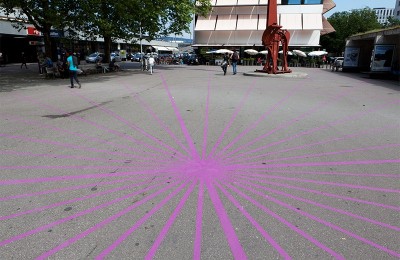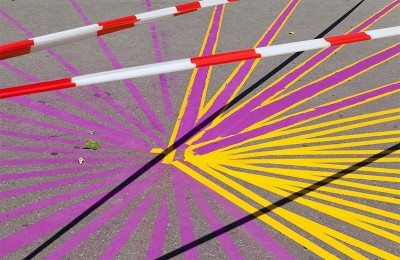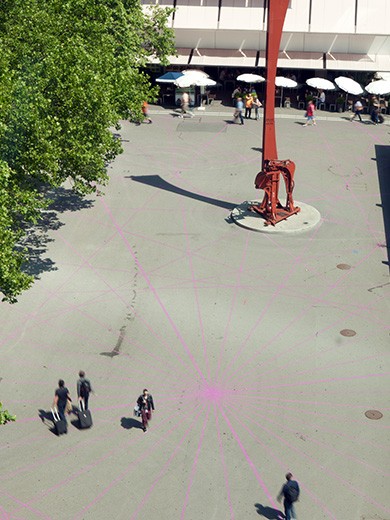Pascal Häusermann
Traits of a Square, 2015

Diesem Werk kann man kaum entfliehen. Die Farbintensität und die Menge an Strichen belegen unausweichlich den Vorplatz des Bahnhofs Zürich Altstetten und geben ihm einen neuen Charakter. Vielleicht ist diese Intervention von Pascal Häusermann (*1973, CH) eine Zumutung, eine Zumutung der Kunst, der man im Alltag üblicherweise mit Gleichgültigkeit begegnet. Viele Passanten filtern die städtische Zeichenhaftigkeit mit Kopfhörern, Smartphones und Sonnenbrillen auf ein für sie erträgliches Mass. Dies dürfte bei Traits of a Square allein aufgrund der Zeichenfülle kaum gelingen. Eine Zumutung ist das Werk wohl auch für jene, die diesen Platz täglich beschreiten, die ihre eingeübten Wege gehen, um ihn möglichst zeitsparend zu überqueren. Zwar stehen ihnen keine Hindernisse im Weg, aber man wird verleitet. Man stelle sich vor, die Pendlerströme würden aufgrund des ausgebreiteten Musters ihr Gehverhalten ändern. Das Strich-Libretto Häusermanns würde neue Wege eröffnen, schnelle und langsame, Irr- und Umwege. Die gut gekleideten Damen und Herren wären ihrer Alltagschoreografie enthoben.
Der Einbruch der Kunst in die Routine des Alltags und dessen Umdeutung, das ist in einer Stadt wie Zürich ein Wagnis, denn der öffentliche Raum ist eine Verkehrsfläche, die effizient bewirtschaftet und auf optimierte Nutzung ausgerichtet ist. Die geometrische Struktur, die einen Sommer lang Aus-, Um- und Irrwege bietet, wurde inspiriert von einer Seekarte Johannes van Keulens, die im 18. Jahrhundert den Seehandel mit Brasilien ermöglichte. Kombiniert wird dieses kartografische Muster mit einem marokkanischen Ornamenttypus, den der französische Forscher Jules Bourgoin im 19. Jahrhundert anfertigte. Pascal Häusermann vereint in Traits of a Square beide Muster zu einem eigenen Kartentypus, der den Charakterzug und die Merkmale des Platzes aufzeigen. Damit führt er sein Interesse an Strukturen weiter, die er in der Vergangenheit bereits in Paris mittels des Metroplans und in Stadtbegehungen erarbeitet hat. Er greift auf Methoden zurück, wie sie die Situationisten in den 1950er und 1960er Jahren vorschlugen, um das Urbane einer Stadt zu erforschen. In ihren «dérives» – im Deutschen mit Abschweifungen zu übersetzten –, wollten sie sich in den Strassen und Gebäuden einer Stadt verlieren und damit den städtischen Raum und Bekanntes neu aneignen. Hoffen wir, dass sich die Menschen auf dem Altstetterplatz einen Sommer lang im Kunstwerk Pascal Häusermanns verlieren, um das zu entdecken, was eigentlich ihr eigener Alltag ist. Stefan Wagner
Courtesy the artist
Dank an: Sabina Bogacz, Julia Rüegg, Gilles Jacot, Gianluca Trifilo, Ingo Groher
English Version
It is almost impossible to escape this work. The colour intensity and the quantity of lines occupy the square in front of Zurich’s Altstetten railway station in a manner that is unavoidable and lend it a new character. Perhaps this intervention by Pascal (b. 1973, Switzerland) Häusermann is an imposition – an imposition on the part of art, which is usually met with indifference during everyday life. Many passers-by use headphones, smartphones and sunglasses to filter down the semiotics of the city to a level that they can cope with. This method is unlikely to succeed with Traits of a Square, due to its abundance of signs alone. It is probably also an imposition for those who walk through this square daily, following their practiced routes in such a way as to cross it in the most timesaving manner possible. Although no obstacles stand in their way, misguidance does occur. Imagine if the flows of commuters were to change their walking behaviour according to the pattern spread out before them. Häusermann’s libretto of lines would open up new paths: quick ones, slow ones, wrong ones and detours. The welldressed ladies and gentlemen would be removed from their everyday choreography.
Art’s invasion of the routine of everyday life and reinterpretation of everyday life: in a city like Zurich, this is a gamble, because the public space is a thoroughfare that is efficiently managed and organised for optimal usage. The inspiration for this geometric structure, which offers escape routes, detours and wrong ways for the duration of a summer, was a nautical chart by Johannes van Keulen, which enabled maritime trade with Brazil in the 18th century. This cartographic pattern is combined with a Moroccan type of ornamentation produced by the French -researcher Jules Bourgoin in the 19th century.
With Traits of a Square, Pascal Häusermann unites both patterns to create a distinct type of map that demonstrates the characteristics and features of the square. He thus continues with his interest in structures, which, in the past, he already developed in Paris via the metro map and in city walks. He harks back to methods proposed by the situationists in the 1950s and 1960s for investigating the urban nature of a city. With their “dérives”, translated into English as “digressions”, they wanted to lose themselves in a city’s streets and buildings, and thus to reappropriate the urban space and the familiar. Let us hope that the people at Altstetterplatz spend a summer losing themselves in Pascal Häusermann’s artwork, so as to discover what their own everyday life actually is. Stefan Wagner
Courtesy of the artist
Thanks to Sabina Bogacz, Julia Rüegg, Gilles Jacot, Gianluca Trifilo, Ingo Groher


